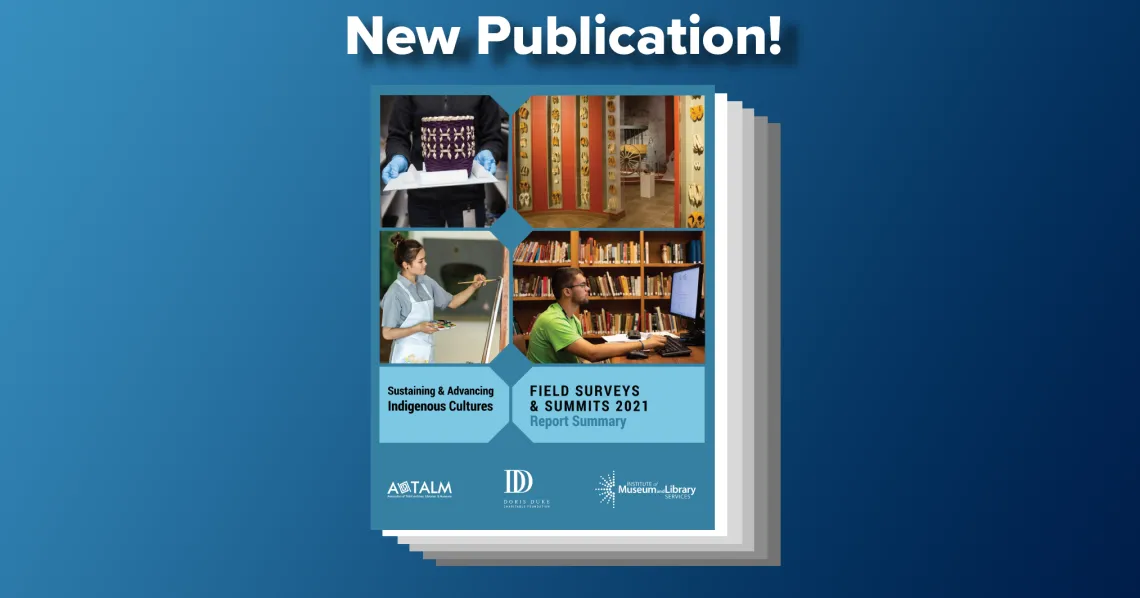‘Sustaining and Advancing Indigenous Cultures’ Reports Published by the Association of Tribal Archives, Libraries, & Museums
The five reports authored by NNI researchers address the needs of Tribal archives, libraries, museums, cultural centers and Native artists and provide an assessment of the state of digital inclusion in Tribal libraries.

The international non-profit Association for Tribal Archives, Libraries, & Museums (ATALM) recently published a set of five detailed reports totaling more than 300 pages authored by Native Nations Institute (NNI) Senior Researcher Miriam Jorgensen and Research Analyst Britnee Johnston (Blackfeet).
The reports were the result of a 2021 grant from the Doris Duke Charitable Foundation to enable ATALM to launch “a strategic planning initiative to develop a unified approach to strengthening Indigenous cultural institutions,” according to the ATALM website.
The published documents are free to read and download. Their contents aggregate and analyze the findings of several surveys of, and public summits with, professionals who work at and with Tribal archives, libraries, and museums and cultural centers (TALMs) conducted throughout 2021. Additional analyses were conducted to identify the level at which these institutions support Native artists and to examine the role Tribal libraries play in supporting digital inclusion in Native communities. Overall, more than 1,500 individuals participated in the summits and over 700 responded to the surveys.
Jorgensen says that this work is important, not just because the institutions are critical cultural resources for the citizens of Native nations, but because the knowledge they steward is crucial to understanding Native nations’ cultural and political identities.
“Tribal archives, libraries and museums; Tribal historic preservation offices; Native artists and culture bearers – these are a critical sector for promoting Tribal sovereignty,” Jorgensen says, “because Native nations need to know what that cultural knowledge is and how their cultures support and animate their (Tribal) governance.”
Findings from the new reports include the following:
- Two-thirds of Tribal archives identified funds for conservation and collections care and to increase tech availability as their most pressing needs.
- More than 40 percent of Tribal library respondents expressed concern that their libraries were unable to provide the services necessary to meet community needs.
- Only one-third of Tribal libraries that responded are stand-alone facilities with many sharing space with schools.
- Additional staff were desired by 60 percent of Tribal museums and cultural centers (TMCCs) that responded.
- A supermajority of surveyed Tribal museums and Tribal libraries said that they supported Native artists, but only half of the Native artists surveyed reported engagement with TMCCs, and even fewer reported engagement with Tribal libraries.
- Nearly three of five Tribal libraries reported that they only met community members’ technology access needs “some of the time,” and a majority reported a need for upgraded public computers and internet access.
Read and download the reports here.
NNI + ATALM: Background
ATALM was incorporated in 2010 as an outgrowth of the first National Conference of TALMs in Mesa, Arizona in 2002 and subsequent conferences in 2005, 2007, 2008 and 2009.
It was founded by then Oklahoma Department of Libraries Development Officer Susan Feller when it became clear that the growing prevalence of TALMs warranted the formation of a dedicated professional organization to support these Tribal cultural institutions.
Feller reached out to the Harvard Kennedy School Project on Indigenous Governance and Development (then the Harvard Project on American Indian Economic Development), where Jorgensen served as Research Director, for support obtaining and analyzing data related to TALMs needs.
Jorgensen had been working in the TALMs-related space since the late 1990s and, because her mother was a career librarian, she had a lifelong association with the field of library sciences and seemed a natural fit for partnering on ATALM’s research efforts.
Jorgensen’s first report for ATALM was published in the fall 2011. The report, titled Tribal Archives, Libraries, and Museums: Education for Professional Growth and Field Sustainability, evaluated the Institute of Museum and Library Services’ (IMLS) grant to the Western Council of State Librarians in support of two national conferences and a variety of additional professional development opportunities for TALM personnel. The report’s findings supported further growth and expansion of ATALM and increased professional development opportunities for TALM staff.
Recognizing a need for baseline data to help set a course for the future of ATALM and the institutions it serves, Jorgensen & ATALM next distributed a national survey to 565 organizations and Native communities to gather information on the state of known TALMs across the U.S.
Data on topics such as staffing, finances, technology, exhibits, visitation and emergency preparedness collected from the 212 organizations and communities that responded to the survey were then aggregated, analyzed and presented in a ground-breaking 2012 report (also authored by Jorgensen) titled Sustaining Indigenous Cultures: The Structure, Activities, and Needs of Tribal Archives, Libraries, and Museums.
In 2013-2014, Jorgensen worked with ATALM and Traci Morris (Arizona State University) on an IMLS-funded survey and report on digital inclusion. This report, entitled Digital Inclusion in Native Communities: The Role of Tribal Libraries, provided the first-ever comprehensive information about the technology and digital inclusion needs of Tribal libraries and the work they do to provide residents of Native communities with access to computers, broadband and technology training. The report was featured in an IMLS public hearing in Washington, D.C. focused on increasing broadband access in libraries and supported increased outreach efforts by the Federal Trade Commission to include Tribal libraries in the E-rate program.
The 2021 project and subsequent reports function as a roughly ten-year follow up to the 2012 and 2014 reports and resulted in five additional documents covering the needs of Tribal Archives, Tribal Libraries, TMCCs, as well as an evaluation of the needs of Native Artists and an assessment of Digital Inclusion in Tribal Libraries.
Read and download the ATALM reports mentioned in this article here.

